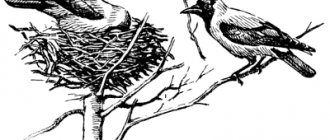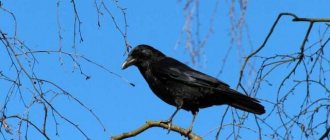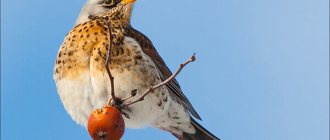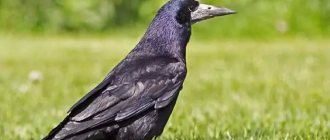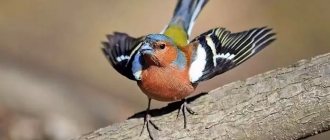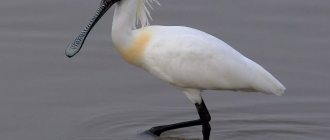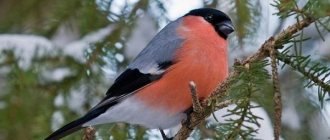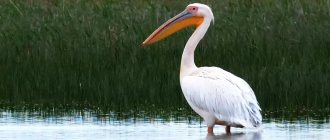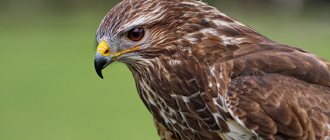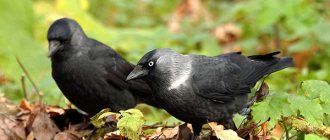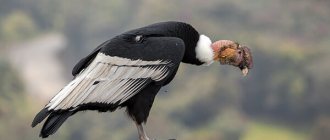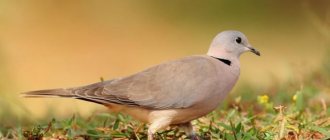Zefirka
> Animals > Where do pigeons, sparrows and crows sleep at night?
It is impossible to imagine the modern urban environment without pigeons, sparrows and crows. During the day these birds seem to be literally everywhere. They sit on trees and wires, fight for every crumb of bread, climb under your feet. Birds have become an organic part of the city background. But where do they go at night? After all, if you go outside after sunset, you won’t hear any birdsong. Where do they spend the night? After all, our environment does not seem to be particularly suitable for birds.
Why is the crow smart, cunning and caring?
The crow is cunning because it knows how to deceive a person who wanted to harm it. And in fairy tales, the magpie is cunning, because it often and very successfully deceives others. 3. The crow is caring because, like other birds, it takes care of its chicks - teaches them to fly, protects them.
Interesting materials:
How to connect SMS alerts to Minbank? How to activate the click SMS service? How to connect SMS notifications from Post Bank? How to connect the Alice station? How to connect a tariff without MTS Internet? How to connect a TV to a computer as a second monitor? How to connect a tulip to a wire? How to connect a webcam on Android? How to connect a second joystick for Xbox? How to connect to a wireless network on a computer?
Overnight
Moonlight does not prevent crows from sleeping.
One day in the evening twilight I was walking along a forest path, encouraging myself by hitting the trees with my staff. And suddenly blackbirds flew out of a young spruce forest with the noise of their wings and squealing. I accidentally scared them away - in the dense silence of the fir trees, the blackbirds had a roosting place... A week later, at the same evening time, I was going to the spruce forest on purpose. Everything happened again. With the clapping of hands and the rustling of a stick, the blackbirds again left their roost...
Everything, looking at night, reaches for home, for lodging for the night. Take a closer look at the flight of magpies and ravens in the evening. A flock of magpies in flickering flight heads from the villages into the forest. Crows from garbage dumps come to spend the night in the city.
One evening from the ski track I watched magpies go to bed. About a dozen of them were sitting on the fir trees and squealing, as if talking to each other, looking out: is everything calm, is there any danger? Occasionally one of the birds would fly up and, after making a small circle, sit on the tree. Another one took off almost immediately. The chattering became less and less loud. Having made sure that I did not pose a danger with binoculars beyond the edge of the forest, the magpies began, with their tails raised, to dive vertically into the spruce forest. The rising moon emphasized the peace of the forest plunged into darkness.
Crows in cities spend the night in all sorts of places. They have favorite trees for roosting - from different sides crows flock to them at night. They also have quiet ritual “interviews” before bed. Then everything calms down. But the heart-rending cry of one of the birds, frightened by something, can raise the entire crow settlement on the wing. During the festive fireworks in Moscow, you can sometimes see how, in the light of rockets, frightened crows rush about in the powder smoke. But the shooting subsides, and the crows sit down again to “talk” before going to bed and then calm down until dawn.
The safest place to sleep is a shelter, preferably a hollow. Woodpeckers and various small birds climb into hollows at night. In severe frosts, it gets to the point where more than a dozen birds, sometimes of different species, are crammed into the shelter - it’s warmer in the cramped conditions.
Squirrels spend the night in a warm nest (gain), plugging the hole into it with moss. Magpies skillfully build nests, but in winter they do not spend the night in them, preferring spruce supports, which provides a service to everyone who is looking for shelter for the night (or day).
On frosty winter nights, black grouse and wood grouse burrow into the snow and there, having made tunnels, they sleep. Some small birds also seek warmth under the snow. But many have to spend the night in trees. In winter and summer, spruce thickets are preferred for this - it’s cozy and safe: no one will approach quietly.
Starlings, before leaving, gather in huge flocks and spend the night in reed thickets. After feeding in the fields, the cranes flock at night to the swamp support, which is inaccessible to anyone who would like to disturb their sleep.
When flying from our places to the south or west, starlings stay in flocks and, like crows, choose a permanent place to sleep. I observed roosting flocks of starlings in the Moscow Zoo and on a crowded street in Palermo (Sicily). There are so many birds gathering that the branches of their favorite tree bend and droppings rain down from above like white rain. In Palermo you don’t walk under such trees without umbrellas. And in the state of Tennessee (USA), where starlings, which never existed in America before, annoy people so much that, having exhausted all means of scaring them off, they place explosives under the “roosting tree.”
Sparrows in winter seek shelter in all sorts of crevices of village houses to spend the night, and in summer they also sleep in trees. They sleep, and not just spend time at night. In Chisinau, an ornithologist who knew this well, before my eyes, performed a rather cruel experiment: he sharply shook a low tree covered with sparrows. Some of the birds flew up, and a dozen fell to the ground like apples. The grasping power of sparrows' legs is small, which is why they fall down without fully waking up. In large birds, especially birds of prey, the tendons of the legs work in such a way that the paws on the branches form a lock; the bird needs to rise on its legs before this lock weakens. Like sparrows, they do not fall from the branches.
Birds' ability to spend the night in trees is so great that, for example, chickens, long domesticated by humans, require perches for sleeping at night. Geese trample or sit on the ground, and chickens certainly look for a “branch.” This need can be so great that in some places chickens prefer to spend the night not in the chicken coop, but in nearby trees. I photographed such lovers of heights in the village of Zeleny Gai near Kursk Lgov. During nesting, the parents' duty is to spend the night close to the chicks. This law is always respected. Moreover, the female spends the night at the nest, while the male sleeps to the side.
In what position can you catch a sleeping bird? The short-legged ones touch the branch with their stomachs, and the long-legged ones sleep on the branch while standing. Some people tuck their heads into feathers, others hide them under their wings.
How do large animals sleep? As a child, my father assured me that elephants sleep standing up. This is only partly correct: elephants can sleep standing up, but they also sleep lying on their sides, as we once saw while driving through the Tanzanian reserve of Manyara. Right by the road we saw several young giants lying on their sides. In the reserve, nothing threatens these animals, and one elephant was in no hurry to get up, enjoying a nap, for which he received a “reprimand” from the female elephant, who pushed the disobedient one with her trunk.
It's hard to imagine a sleeping giraffe. He seemed destined to sleep standing up. No, with his legs bent, he sleeps as if “sitting”, leaving his long neck in an upright position. For ostriches, the neck is also a hindrance. But when they go to sleep, in order to remain unnoticed by predators, they stretch their necks parallel to the ground, giving birth to the legend: “Ostriches hide their heads in the sand so as not to see the danger.” And smart chimpanzees build special nests in trees for sleeping - not yet a home, but you still have to strive here at night.
For all animals that are active during the day, it is preferable to go to a shelter at night, or at least to a well-known place, so that in case of danger they know where to hide. By sunset, the bees are rushing to their hives, and the ants are rushing to their anthills. Once, I marked an ant hurrying to spend the night with a tiny tear of paper from a notebook and watched with interest as he hurried along the odorous path of his fellow tribesmen to his castle, but lost his strength and decided to spend the night in one of the shelters existing on the ant roads.
Other insects spend the night where night finds them, but they try to find a cozy place somewhere under a leaf, in some crevice.
Do the inhabitants of the waters sleep? Not everything is known here. Catfish, for example, hunt at night. Fish that find food by smell (bream, carp) are also active at night. And pikes apparently sleep, since it is not their sense of smell, but their sight that gives them success in hunting. Sleeping fish in the water often take strange poses - they bend their heads towards the bottom or seem to fall slightly on their side. Dolphins, as established by experiments, can sleep while moving - their two brain hemispheres work in turns: one sleeps, the other is awake.
Many animals sleep during the day and are awake at night. A close example is our cats. Foxes and wolves also hunt at night and sleep during the day, although when they are hungry they prowl and look for prey during the day. Lions in Africa are most often seen sleeping during the day, often in bizarre poses. One, desperate to wake him up with a car horn and a knock on the iron with a key, I was forced to throw a nut on his stomach. The lion raised his maned head and stared at me with the eyes of a creature, dissatisfied with being woken up. The others in his company didn't even move. Lions have practically no enemies (except that the mother worries about the helpless babies), but there is a danger: the rulers of the savanna can be accidentally trampled by buffalos or large antelopes. In the Manyara Nature Reserve, I photographed lions sleeping in the trees. They looked like skins hanging out to dry.
The rulers of the dark time - owls - sleep during the day and stay awake at night. The light of the moon or even the stars not hidden by clouds is enough for them to see a mouse on the ground, pinch a hare or a bird sleeping on a branch. True, hearing also helps them a lot. The barn owl, as they say, even without seeing it, can accurately determine by its rustle where the mouse is and confidently catches it.
Desert inhabitants, out of necessity (it’s hot!), sleep in underground shelters during the day. All the not very rich life of the desert awakens at night, and in the morning you can find out about it by footprints in the sand, by someone’s feathers and bones. To get an idea of how nocturnal animals live, in some zoos night and day are reversed. The lights in the enclosures are turned on at night, and the animals fall asleep, and during the day, visitors see them as if in the ghostly light of the moon. You can watch how a monitor lizard walks and jerboas jump, how a caracal warily pricks its ears with tassels, moths flutter, and you see bats in broken flight. The late Professor Grzimek showed me such a night at the Frankfurt Zoo. There is such a “night” now in the Moscow Zoo.
All animals are adapted in their own way to the rhythms of day and night. Some people benefit from darkness for their activities, but most of everything on Earth is active in the sun and sleeps at night.
Reproduction in captivity
Raising ravens at home is quite difficult. To hatch chicks, you need a spacious aviary, with conditions close to the natural environment. It is unlikely that it will be possible to breed birds in a small apartment.
To breed chicks in captivity, you need a female and a male raised by humans. In this case, the birds will trust him and feel safe. At the beginning of spring, a male raised by another person can be placed with the female. If there are several males in the enclosure at once, they can fight for the attention of a female.
In a spacious enclosure you need to collect a lot of twigs, from which a pair of ravens will build a nest. They themselves will choose a secluded place in the enclosure to lay eggs, where they will feel comfortable and safe. You cannot climb into the nest and touch the eggs. This will greatly frighten the birds.
Feeding the chicks
When chicks are born, you need to help the birds feed them; in captivity, it is difficult for adults to get food for them themselves. Feeding should be done every 2 hours. Proper nutrition should consist of cooked buckwheat and oatmeal, small pieces of meat, eggs and grated carrots.
Note! Chicks can be given baby cereals and meat purees, but they should not contain milk.
For good growth and good health of babies, food must be rich in vitamins and minerals. Additionally, you can purchase useful supplements for chicks at the pet store. This is especially important for the raven in winter and during the cold months of the year.
Useful vitamins to improve bird health
Upbringing
Raising small chicks, which have been accustomed to human society since childhood, is not as difficult as raising adults. Every day, kids need to spend several hours a day training and playing with them. Classes should begin when the chicks grow a little and begin to walk. If you talk to them a lot, they will repeat sounds and words after the person.
Grown-up chicks need harnesses - straps that are attached to their legs. By allowing them to fly outside the enclosure, the device will keep the bird close to its owner, and it will not be able to fly far. After some time, when flying without restraints, the pet will return to its owner.
A little biology
City, or gray crow
(Corvus
cornix
) belongs to the Corvid family, order Passeriformes. Birds have a gray body; the head, chest, wings and tail are black with a bluish metallic tint. The eyes are dark, the beak and legs are black. Juveniles have a brown coat and blue eyes. Birds move along the ground with long strides and, in case of danger, begin to jump. Life expectancy is 20 years.
Crows have a very rich language of communication. We are used to hearing only croaking, but it has many shades and intonations. For example, males make special sounds when courting a female. Specific sounds are used to communicate with young animals. Crows have special danger or alarm signals. When birds quarrel among themselves, they use their own special “language.” If you need to quickly gather into one flock, several birds make the same sound in unison. This is for loudness so that all team members can hear that a general gathering has been announced.
Crows build new nests in the spring; very often they renovate old ones left over from last year. Any material is used for construction: twigs, wire, metal clothes hangers, wool, dry grass, rags. The nest is a joint product of the work of a male and a female. When the nest is ready, the female lays 4-5 greenish-bluish eggs there.
Population and species status
Photo: Raven bird
In earlier times, especially in the 19th century, the raven was persecuted by humans. It was considered a symbol of misfortune and a harbinger of troubles; in addition, the raven was accused of destroying crops. All this led to the fact that the bird began to be actively destroyed, including with the help of poisons. This caused a sharp decline in the population. Later, some European countries began to correct the current situation by taking the raven under protection. Such measures bore fruit, and the number of ravens began to increase.
An obstacle to increasing the raven population in some regions is difficult winter conditions, which make it difficult to obtain food. Human development of new territories subsequently leads to an increase in the raven population in this region. The explanation is simple: where there is a person, there will always be food waste. The classic black raven is widely known to all residents of the European part. But the squad of ravens is quite numerous and is not limited to only this species.
Depending on the geographical location, the following types of ravens are known:
- Antillean raven;
- New Koledonsky raven;
- White-billed Raven;
- Gray Raven;
- American Crow;
- Piebald Raven;
- Shiny Raven;
- Flores Raven;
- Cuban Raven;
- Cape Raven;
- Giant Raven;
- Pygmy Raven;
- Bismarck's Raven;
- Jamaican Crow;
- Guam Raven;
- Desert Raven;
- Trumpet Raven;
- Palm Raven.
Some of the above species of ravens are distributed over a fairly limited area and their populations are rather small. Others live more widely, but more often within the same continent. The classic black raven, most adapted to any living conditions, thanks to which we know it for what it is.
Nutrition
Crows eat almost everything. For example, if a bird finds a crust of bread, it will never peck dry bread, but will find a puddle to soak the crust and then swallow it with appetite.
Crows, hunting wherever possible, have achieved unprecedented virtuosity in unpacking bags and boxes. Any crow can unwrap a candy wrapper without damaging it, open a bag that contains something edible, or open a matchbox with its paw if it is interested in something.
Birds very quickly adapt to life in the city: they find and remember places where they can get food, try new foods and develop various techniques to “get their daily bread.”
For example, in the 70s and 80s they began to produce milk and kefir in triangular bags. Some smart crows sat on tree branches and waited for dairy products to be delivered to the store. When the car arrived and unloading began, the bravest ones grabbed the bag by the tail on the fly and quickly ran away...
